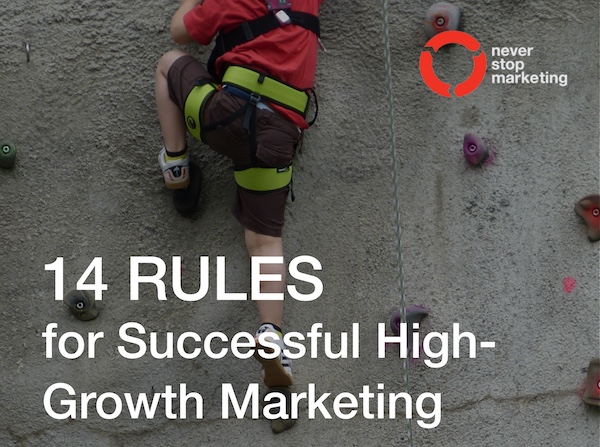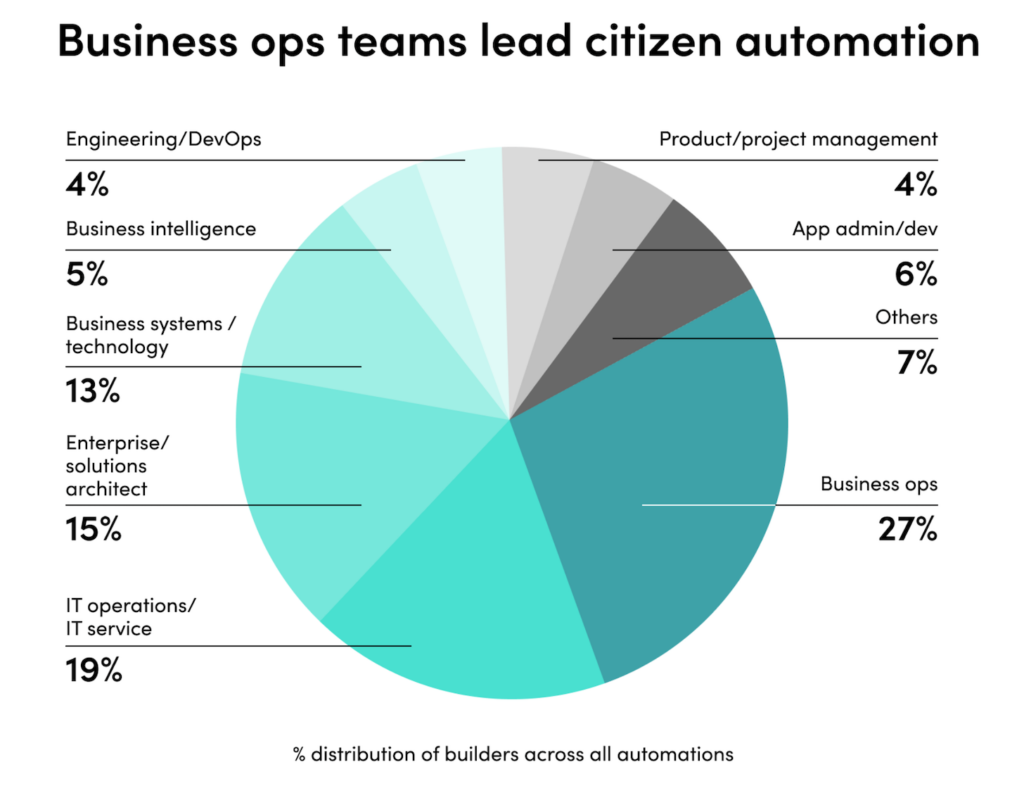The following is a guest post by Jeremy Epstein, CEO of Never Stop Marketing. He served as VP marketing at Sprinklr as the company grew from 30 people and a valuation of $20 million to 1,400 employees, valued at over $1.8 billion. The following is an excerpt of his new whitepaper, 14 Rules for Successful High-Growth Marketing.
A “unicorn” company is one that achieves a private market valuation over $1 billion dollars. Growing as quickly as we did at Sprinklr helps you realize what’s essential for great marketing and what’s not, particularly if you are a start-up. The same applies even if you’re trying to jump start your marketing initiatives. As a former mentor said to me, “marketing is less about the sexy part and more just rhythm and process.”
Hopefully, you can benefit from our hard-earned lessons to accelerate your own efforts.
It’s critical to note that marketing isn’t all you need. I was fortunate to work for a great CEO, with many extremely passionate and talented people, and have a great product behind us. In other words, it was a serious team effort.
However, as the person responsible for marketing, I found these 14 rules for successful high-growth marketing helpful and hope you will too. I’ll highlight 6 of the 14 here and look forward to your feedback.
Rule #1: Don’t Confuse Activity With Outcomes
Activity feels good. Make a checklist, get the stuff done, check it off. But that’s not what you are paid to do.
If your goal is to lose weight, and you say, “well, I’m going to the gym every day, but the scale says nothing has changed,” then you are focused on activity, not outcomes. It’s critical to be super clear with yourself — and your team — about what you are trying to accomplish.
I’ll give you one example.
We had a telemarketing team (I called them “individual outreach”). Their job was to identify the right people at a target organization (we were going after Fortune 2,000) and secure meetings. A lot of orgs call these people “inside sales.”
Most teams like this send a boatload of emails that are copy/paste saying, “Here’s what we do, can I have 15 minutes of your time?”
It’s “spray and pray.” I know this to be the case because as VP marketing, I was on the receiving end of a ton of these.
While it does work (a bit) and generates some meetings, it doesn’t consider the number of people who now think less highly of your company. It also doesn’t really move the relationship between you and the prospect forward in any meaningful way.
Here’s what we did differently:
Our team would meticulously research people.
We looked at their Twitter profile, LinkedIn, blog posts, etc., until we had as deep an understanding of the person as we could get.
Then, each team member would write a highly customized, personalized email that clearly demonstrated the fact that he had done the research about the prospect (without being creepy — though admittedly, some people didn’t like it).
If you liked baseball, we would comment on it.
If you had just come back from a trip, we would ask about it.
If you recommended a book or an article, we might read it and explore the topic.
The point was: we took the time to get to know you as a person, and we were trying to engage on that personal level.
What happened?
We sent out a lot fewer emails per day than a typical organization, but our response rate was astronomical. People saw that we actually gave a damn about them as people. Not as number, but as real people.
They responded with comments such as:
- “This is the best pitch email I have ever received.”
- “Anyone who does this amount of work before contacting me is the kind of company I can respect.”
- “What a refreshing change from the usual copy/paste!”
And this was a key driver in growing leads by 400% YoY.
The Lesson
This approach of highly personalized emails may not work for everyone and that’s fine, but the key thing we did was just asking ourselves, “What do we need to do?” Drive more initial meetings/leads.
Then we said, “Okay, given the way the world works today, what can we do to increase the likelihood of achieving that outcome?” But always stayed focus on the outcome.
Rule #3: Build Your Community of Advocates
While the advertising on the Super Bowl can be funny, emotional, or sexy, don’t get caught up in the glitz. You’re watching the Alamo of brand advertising and, unlike the really big guys (or people who don’t care about their money as much), you don’t have cash to burn.
The fundamental, earth-shaking shift that marketing has undergone in the past ten years is the explosion in the number of channels and the hyper-connectivity among people-anywhere, anytime, for free. To think that marketing would not change dramatically when the entire structure of modern life has been so upended is insanity.
That’s why our entire marketing effort began and focused almost entirely on our natural communities.
As we’ve all seen during the past election cycle, you’re not going to change people’s minds. Key point here: you’re going to be far better off finding the people who naturally agree with your worldview and turn them into raving fans than pretty much anything else.
I consider myself a disciple of Seth Godin, having become a fan after hearing him speak in New York in 1998. All we did was take his various ideas and put them into practice.
He calls this “First, Ten.”
He’s not alone though. Clay Shirky suggests 100 (I fell in love with his book 9 years ago). Kevin Kelly says it’s 1,000.
Again, the concept is the same. All we did was execute against it.
My personal favorite was our events. We did over 100 meet-up style events around the world, hosted by our clients and prospects, in which the presentations were attendee-driven.
Rule #4: Ask Not What Influencers Can Do for You, Ask What You Can Do For Them
Imagine you had a big social media following or gave a lot of presentations. Then, imagine that every single day, you get an email from some start-up saying, “Hey, will you promote our site, our product, etc., to your entire list?”
Why should they? What’s in it for them?
These “influencers” have built up a reputation as a trusted source of information. If they start flooding their feeds with “noise” instead of “value,” their influence will plummet. That’s not in their interest.
Instead, focus on how you can make influencers even smarter and more valuable.
Do you have proprietary data you can send them? Interviews with clients or early adopters? Cool use case stories?
That’s what they need. Give, give, give and then give some more until it hurts. It will be worth it in the end.
Rule #6: Do Creative Outside; Do PR In-House
You’re a technology start-up, not a creative agency. When you have a contract with a creative agency, you will more easily stop yourself from doing all the stupid things you come up with that you would just do if you had creative in-house.
The “Shiny New Object Syndrome” is real, especially at start-ups looking to move fast. You protect yourself from questionable creative ideas (and there are many) by putting the costs of paying them as a stop-valve. This creates the natural checks and balances that you need.
Without this built-in protection, you increase risk because you’ll end up burning a lot of time and money on the debatable creative ideas since the resources (your employees) are already paid for.
That being said, having a junior designer on staff who is just polishing PowerPoints so your sales guys and execs don’t put up total garbage does pay for itself.
On the flip side, PR agencies are great when you need surges of attention. For big “moments in time” (e.g., funding rounds or major product announcements), call in the reinforcements.
But the real value of PR comes from patience, focused storytelling, and non-transactional, external relationship-building. That’s how you climax to a series of great featured articles. You need someone with sustained attention and loyalty to your company. Plus, it’s almost always way cheaper.
Bottom line: in the very early stages, particularly in a disruptive market, you’re going to pay an agency a ton to educate them. The ROI isn’t there.
Key caveat: every now and then, you find an agency that really gets an industry, but they are few and very far between.
If you want to get super-technical, this is an extension on Coase’s Nature of the Firm.
Rule #10: Don’t Let the Perfect Be the Enemy of the Good (or the Corollary from Steve Jobs: “Real Artists Ship”)
Your job is to put items in market. What’s true for developers is true for marketers. You must be sensitive to the needs of the company and larger market trends. Respect your brand, yes, but you can’t wait forever. You need to move the market.
“Ship it!”
Rule #13: Communicate the Strategy
Write your strategy statement. Use the framework in this article. Make sure everyone knows it.
You will know if you are failing by doing an occasional pop quiz on your team. Ask them, “What’s our strategy statement?” Have them write it down for you right there. If everyone doesn’t write the same thing, you’re not doing your job.
Conclusion
I was a history major in college, so perhaps I’m biased, but I believe that learning from the mistakes of others is one of the cheapest ways to get ahead.
This is by no means an exhaustive list, but it might get you going in the right direction, save you time, money, and headaches, and free you up to make other errors.
Good luck, and never stop marketing.
Dedication: A big thank you to Brian Kotlyar, AVP of Marketing at Sprinklr for much inspiration, assistance, and refinement of these ideas and this article.
Thanks, Jeremy!
Readers: Jeremy will be speaking at the MarTech Conference in San Francisco, May 9-11, with a fantastic presentation on Marketing in a Blockchain World. Register now for the lowest “alpha” rate on tickets to guarantee your seat.




I love Rule #6 and in many ways, I agree. The trouble is most startups tasked PR as an additional duty and you wind up educating no one. A better solution is to hire a firm and think of them as an extension of your team, rather than as an expendable transaction. You can’t buy PR like clicks, at least not the kind that will do you any good.
@Frank That’s a good and fair point. It needs a dedicated resource and can’t be an add on. Worthy of clarification. That being said, I still thing the ROI on the firm vs. the FTE isn’t there, with very few exceptions.